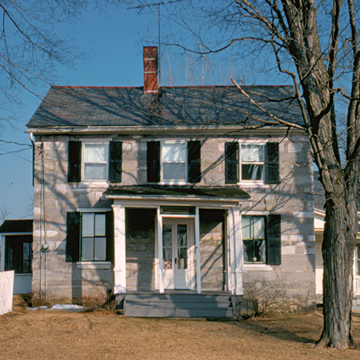Facing west to Lake Champlain, this small house built of random ashlar limestone blocks is typical of the vernacular stone building tradition that flourished near the lake in parts of Addison and Rutland counties during the first third of the nineteenth century. The three-bay, central-hall house is thought to have been built for James TenBroeke, who immigrated here from England around 1820. TenBroeke seems to have been a substantial farmer judging by the sheep barn and cow barn in the farmyard north of the house, both built c. 1830. An attractive late-nineteenth-century courtyard arrangement with another barn and sheds has since engulfed his early barns.
There are random ashlar stone warehouses, stone smith shops, and stone houses scattered through all of the lake towns from Benson and Hubbardton north to Ferrisburgh. Although there are a number of larger Georgian-plan stone houses in Ferrisburgh and Addison, where stonemason William Hasbrook lived, relatively plain three-bay central-hall stone houses appear frequently in Ferrisburgh, Panton, Addison, and Benson. Stone one-room district schools were also popular, with examples remaining in Benson, Cornwall, Orwell, Panton, Sudbury, and Shoreham.







